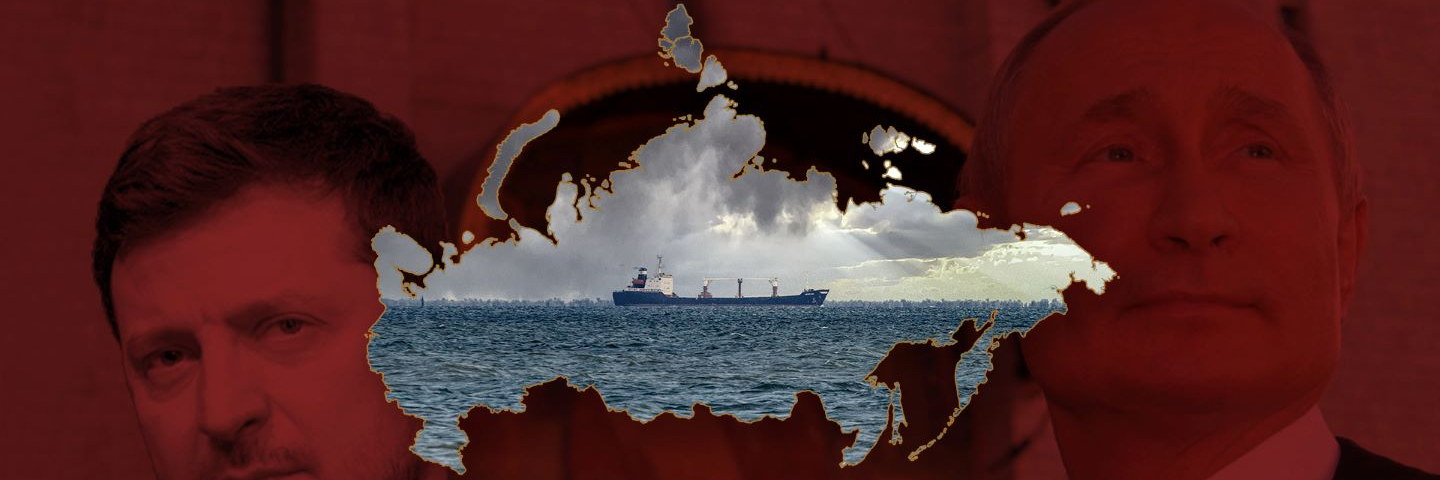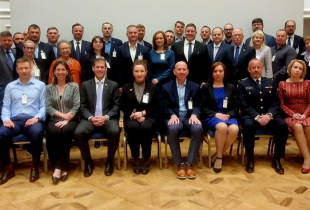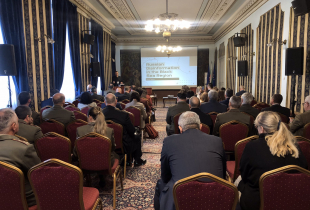
Russia End State: Battle for the Black Sea
Introduction
Russia’s occupation of Crimea in 2014 seized or sank a large portion of the Ukrainian Navy. In 2017 Chief of the General Staff Valery Gerasimov asserted that Russia had built a “self-sufficient” (самодостаточная) grouping of forces in Crimea, and that Russia’s Black Sea Fleet (BSF) could assert naval “supremacy” over what was, in effect, a “Russian lake.” Ukraine’s own strategic identity and culture viewed itself as a land-based rather than maritime power, despite its long coastline along the Sea of Azov and the Black Sea. In February 2022, Russia’s full-scale multi-axis attack on Ukraine led the Ukrainian Navy to scuttle its flagship rather than having it captured. In the initial stages of the invasion, Russia looked to carry out an amphibious operation against Odesa. Ukraine appeared even more vulnerable, particularly in the maritime domain. Russian assertions of “maritime supremacy” appeared well-founded.
However, by March 2024, Ukraine, entirely lacking a traditional navy, has sunk or damaged around 30% of Russia’s BSF, which comprised approximately 80 vessels on February 24, 2022. In November 2023, President Zelenskyy addressed the meeting of the Parliamentary Assembly of the Black Sea Economic Cooperation (PABSEC) and stated that Ukraine had seized initiative in the Black Sea and that Russia was unable to further use the sea as a military foothold to destabilize the situation in the region. On January 2, 2024, Zelenskyy went on to note that the isolation of Crimea and the related battle in the Black Sea would become “the center of gravity of the war,” steadily weakening Russia’s military potential. The loss of Crimea, “the centerpiece of Kremlin propaganda,” would show that “thousands of Russian officers have died just because of Putin’s ambitions.” On February 15, 2024, NATO Secretary General Jens Stoltenberg reinforced this conclusion, noting that: “the Ukrainians have been very capable of attacking the Russian Black Sea Fleet, they have destroyed a large number of ships” and highlighting “the great victories that Ukraine has achieved in the fight against the Russian Black Sea Fleet.”
We are witnessing a real-time shift in the maritime balance of power in the Black Sea. This paper seeks to provide an explanation for Ukrainian success and assess the significance of this “sea change.” Why, in hindsight, was February 23, 2022 the high-water mark of BSF operational capability? Given that the BSF plays a supporting role for land-based operations, does its steady degradation have a strategic implication for the course of the war?
Ukrainian Asymmetric Warfare; Russia’s BSF “active defense:”
Ukraine has used a combination of unmanned naval vehicles (UNV) and missile strikes (SCALP/Storm Shadow) to great success. MAGURA V5 Maritime Autonomous Guard Unmanned Robotic Apparatus V-type are controlled via a satellite or a radio network and can be easily launched from any remote location. Ukraine has deterred BSF amphibious attacks, pushed Russia’s BSF out of the northwestern Black Sea and Crimean seaports to the relative safety of the eastern Black Sea, and thus lifted the blockade on its maritime trade and partially freed its commercial trade. They have also degraded Russia’s ability to carry out sea-launched missile attacks against Ukrainian land-based Critical National Infrastructure (CNI).
These advances also pressured BSF support of its Mediterranean Squadron and the maritime “Syria express” resupply effort of Russian forces deployed in support of the Assad-regime in Syria, rendering Russia’s posture in Syria much less flexible regarding withdrawal. BSF losses imply Russia’s operational presence in Syria becomes a trap. Ukraine has become a naval power without a navy.
Türkiye and Ukraine share opposition to Russian hegemony in the Black Sea region and as such are “natural allies.” Ukraine has become an indispensable element of Türkiye’s regional order strategy, serving as a counterbalance and degrading Russian maritime power without triggering a Russian collapse, internal destabilization, or radicalization. The 1936 Montreux Convention (Articles 19, 20, and 21) allows Türkiye to close the straits to military vessels in a time of war, recognizing Türkiye as the gatekeeper of the Black Sea’s naval traffic. Only ships designated as belonging to Black Sea littoral states and home-ported in the Black Sea prior to the start of hostilities have guaranteed access to the Black Sea in time of war. Thus, other ships of the Moskva-level in the Russian navy that did not enter the Black Sea before the war began, cannot do so now. Türkiye geopolitically balances boosting defense cooperation with Ukraine, while avoiding joining the Western sanctions’ regime against Russia. Türkiye manages to be pro-Kyiv without being openly anti-Moscow. Complementarities between Turkish and Ukrainian defense industries, as evidenced by Ukrainian jet engines considered for the Turkish KAAN jet and new-generation drones, and Türkiye constructing Corvettes for the post-war Ukrainian navy, are increasing and becoming more strategic.
The BSF evolved operationally throughout 2022. In March and April 2022, the BSF prepared for an amphibious operation against Odessa in support of Russian ground forces that had “broken” out of Crimea, taken Kherson, and then stalled at Mykolayiv. Given that the role of the BSF is to support land operations, failure to advance on land put the amphibious support option on hold.
In the summer of 2022, the BSF focused efforts on enforcing a blockade on Ukrainian maritime trade (fertilizers, grain, and industrial products) from its remaining ports to the Bosporus Straits and wider world. Ukraine’s sinking of the BSF’s flagship Moskva seriously degraded the BSF’s air defense and situational awareness in the NW Black Sea, a situation reinforced when Ukraine restored control over Snake Island and retook the “Boyko” oil towers “Petro Godovalets” and “Ukraine,” as well as the “Tavrida” and “Svyash” gas drilling platforms which had been under Russian control since 2015. These platforms had mainly been used for logistical support of Russian operations as well as surveillance and intelligence gathering and monitoring of Ukrainian activities. As a result of Ukraine’s attacks, the BSF could no longer enforce a blockade. Deputy Prime Minister and Minister for Development of Communities, Territories and Infrastructure Development Oleksandr Kubrakov reports that almost 30 million tons of agricultural produce have been exported from Ukraine since August 2023 via the Black Sea corridor established by Ukraine. More than 1000 vessels have used it since August: “In the shortest month of the year [February 2024], Greater Odesa ports processed eight million tons of cargo, of which 5.2 million tons were products of Ukrainian farmers. These are record export figures not only for the Ukrainian corridor, but also for the [whole] period of the full-scale invasion. We are gradually approaching the pre-war levels of export through these ports. Today, more than 90% of all agricultural exports go through the ports of Greater Odesa and the Danube ports. Ukraine remains one of the key guarantors of food security. This is especially true for grain exports to Africa and Asia. Since the launch of the Ukrainian Corridor, 42 countries have received almost 28 million tons of cargo, including 19 million tons of grains and oilseeds.” As of March 1, 2024, 113 vessels were currently waiting to enter the ports of Odesa, Chornomorsk, and Pivdennyy, with almost three million tons of cargo to be exported.
The third evolution of the BSF core mission began in the fall of 2022. The focus was sea-launched Kalibr cruise missile attacks on Ukraine’s CNI. Ukraine countered by UNV attacks on Kalibr-carrying BSF assets as well as the port of Novorossiysk. In 2022 it is estimated that the BSF could fire a Kalibr salvo of 70 missiles; today salvo capacity is said to be 40. Unconfirmed reports suggest that, once fired, Kalibr cruise missiles can only be reloaded at Sevastopol - where BSF assets can be more easily targeted by Ukrainian UNV or missile fire.
Russia and the Strategic South
Any Russian objective assessment of its role within the “strategic south” will need to acknowledge the impact of the progressive destruction of Russia’s BSF and its implications for Russia. First, Türkiye emerges by default (Ukraine’s slow decimation of the Russia’s BSF) and by design (due to its own shipbuilding program) as the dominant Black Sea maritime power. Russia’s attempts to reinforce the BSF in late 2021/early 2022 resulted in weakening of the amphibious capabilities of the Baltic and Northern fleets, which cannot be restored in the near term. Many intelligence analysts in the Baltic region warn that Russia can rebuild the military capacity to threaten its neighbors in 3 to 5 years, but in the Black Sea theatre, restoration of Russia’s capacity for projecting maritime power cannot happen in such a time horizon. Russia will not be able to rebuild its BSF naval assets while the war continues and Türkiye can enforce the Montreux Convention. In short, Russia has lost the capacity to project force from beyond the Black Sea and force projection within it is circumscribed.
The degradation of Russia’s BSF (more than 20% in the last 5 months alone) is critically enabled by NATO support for Ukrainian targeting by manned or unmanned AWACs-type assets that can provide real-time information to the Ukrainian Armed Forces. By contrast, Russia’s BSF is effectively blind, reflected in the loss of command and control flagships such as the Moskva and Admiral Makarov, the destruction of Il-20M/22 and A-50 AWACS aircraft and sensors on hydro-carbon infrastructure, and Snake Island in the NW Black Sea. Russia’s A-50 is able to ensure quick coordination between sea, air, and land assets, especially the air force and missile forces. The steady destruction of these enabling assets reduces the intensity of Russian land force operations. As a result, and uniquely, one combatant with no surface ships but excellent targeting capabilities degrades the large surface fleet of the other combatant, which suffers from inadequate targeting ability. Ukrainian naval drone “wolf packs” are easily detectable from the air, but the BSF is lacking the air surveillance capabilities.
Historically, the BSF’s degradation and even destruction is more traditional than not. It was a factor in the Crimean War (1854-55), Russo-Japanese War (1904-1905), the First and Second World Wars, and now again after 2022. What is clear though, is that today the importance for Russia of holding onto Crimea far outweighs BSF losses. In this sense, for Russia, Crimea is the “center of gravity” in the Black Sea, not the BSF, and as such, retention of Crimea is of paramount importance. In addition, BSF degradation has not impacted the volume of Russian maritime trade from Crimean ports (stolen grain and other commodities from the occupied territories of Ukraine) and Novorossiysk to global markets, but western sanctions have. For Russia, the center of gravity in this war is its ability to maintain a military numerical superiority in the land-based main theatre of operations. Here, Ukraine’s shortage of manpower is critical to its ability to fight and constitutes a potential game-changer unless it can be addressed through a new round of mobilization. Europeans are on track to address artillery shells and other ammunition deficits and the Pentagon has just made a surprise announcement about a $300 million weapons package for Ukraine, the first batch of U.S. military aid this year.
Increased interest in, and vision for, the region from the United States and NATO – part of the U.S. Black Sea Strategy – highlights the twin realizations that “what happens in the Black Sea does not stay in the Black Sea” and that the Black Sea itself should be understood as an enlarged geo-strategic space. This space begins in Iranian ports on the southern shores of the Caspian Sea, links through the Volga-Don canals to the Sea of Azov (now a Russian lake) and concludes in the Black Sea itself. It becomes an arena of strategic competition between Iran and Russia, as well as Ukraine and the West, with Türkiye playing a delicate balancing role and China increasingly engaging in the region. This finds expression, for example, in joint Russian-Iranian drone production and emphasis on north-south trans-Caspian trade routes and China, Türkiye, and Ukraine on east-west “Middle Corridor” routes.
Conclusions
Occupied Crimea’s presumed A2/AD “bastion” is downgraded, but the logistical hubs still operate near full capacity. Ukraine’s ability to systematically degrade Russian military assets in Crimea is as yet unproven. F-16 and Taurus deliveries will make a difference, as will the continued availability of real-time targeting information supplied by NATO member states. But the question remains as to how even best-case scenarios regarding Ukrainian maritime domain successes impact the course of land warfare.
Ukrainian highly visible and well publicized successes in degrading Russia’s BSF resonate with the Ukrainian public and internationally signal Ukraine’s will to fight. These successes have also changed perception and narratives. First, Russian naval power projection has taken a hit, as has the supposed efficacy of its maritime capabilities. Second, after amplifying Russian “red line” threats of an “instant” and possibly nuclear “Judgement Day” retaliation (Dmitry Medvedev, July 2023) if Ukraine dares to attack Crimea, the pro-Kremlin media on the peninsula began by ignoring or downplaying the September 13, 2023 devastating attacks on Sevastopol’s dry docks (“not critical”) and on a BSF landing ship and submarine. As a result, and third, Ukrainian military successes have brought the status of Crimea back into play. The notion now of de-occupation of Russia’s supposedly sacred territory is a reality. Crimea has been reduced in status to other occupied Ukrainian territory and its Russian-controlled airfields, ports, and maritime vessels are all legitimate military targets. This was not the practice, even if it was de jure the case, prior to February 24, 2022. Ukraine gradually demilitarizes Crimea – through targeting military assets or deterring Russia from stationing its fleet in Crimean ports - and in this sense de-occupies it as well.
The Kerch Bridge may become a symbolic target. In this respect, the targeting of BSF air and sea defense platforms or cross-strait ferries that enable military logistics has the same effect in closing the bridge as would hitting it directly. Indeed, Russian land-routes connecting the Crimean isthmus with Russian occupied Ukraine are much more vulnerable and consequential than the Kerch Strait Bridge itself. In addition, deterring the 5 million Russian tourists that visited occupied Crimea in 2023 would undercut the economic viability of the most significant of Russia’s territorial conquests. Lastly, constant low cost, highly visible Ukrainian attacks on Crimea suck in Russian forces to defend the territory (Rosgvardia, air defense, combat aviation) and so reduce available manpower from the rest of the battle front.
GCMC, Garmisch-Partenkirchen, March 12, 2024.
About the Authors
Dr. Pavel K. Baev is Research Professor at the Peace Research Institute Oslo (PRIO). He is also a Senior Non-Resident Scholar at the Brookings Institution (Washington, D.C.) and a Senior Research Associate with the French International Affairs Institute (IFRI, Paris). Dr. Baev specializes in Russian military reform, Russian conflict management in the Caucasus and Central Asia, energy interests in Russia’s foreign policy, and Russian relations with Europe and NATO.
Dr. Yevgeniya Gaber is a Ukrainian foreign policy expert. She joined the GCMC’s faculty in November 2023. Prior to this, she worked as a Foreign Policy Advisor to the Prime Minister of Ukraine (2021), Deputy Director of the Diplomatic Academy at the Ministry of Foreign Affairs of Ukraine (2018-2020), and political officer in the Embassy of Ukraine in Ankara (2014-2018). Her research interests cover European and Black Sea regional security, with a focus on security and foreign policies of Ukraine, Russia, and Turkey. Dr. Gaber is widely published and has given presentations and lectures to the Estonian School of Diplomacy, Geneva Centre for Security Policy, NATO Professional Development Program, and leading universities in Europe, Canada, and the United States.
Dr. Dmitry Gorenburg is Senior Research Scientist in the Strategy, Policy, Plans, and Programs division of the Center for Naval Analysis, where he has worked since 2000. Dr. Gorenburg is an associate at the Harvard University Davis Center for Russian and Eurasian Studies and previously served as Executive Director of the American Association of the Advancement of Slavic Studies (AAASS). His research interests include security issues in the former Soviet Union, Russian military reform, Russian foreign policy, and ethnic politics and identity. He currently serves as the editor of Problems of Post-Communism.
Dr. Graeme P. Herd is a Professor of Transnational Security Studies in the Research and Policy Analysis Department at the George C. Marshall European Center for Security Studies. His latest books include Understanding Russia’s Strategic Behavior: Imperial Strategic Culture and Putin’s Operational Code (London and New York, Routledge, 2022) and Russia’s Global Reach: A Security and Statecraft Assessment, ed. Graeme P. Herd (Garmisch-Partenkirchen: George C. Marshall European Center for Security Studies, 2021).
The George C. Marshall European Center for Security Studies
The George C. Marshall European Center for Security Studies in Garmisch-Partenkirchen, Germany is a German-American partnership and trusted global network promoting common values and advancing collaborative geostrategic solutions. The Marshall Center’s mission to educate, engage, and empower security partners to collectively affect regional, transnational, and global challenges is achieved through programs designed to promote peaceful, whole of government approaches to address today’s most pressing security challenges. Since its creation in 1993, the Marshall Center’s alumni network has grown to include over 16,000 professionals from more than 160 countries. More information on the Marshall Center can be found online at www.marshallcenter.org.
The Clock Tower Security Series provides short summaries of Seminar Series hosted by the George C. Marshall European Center for Security Studies. These summaries capture key analytical points from the events and serve as a useful tool for policy makers, practitioners, and academics.
The articles in the The Clock Tower Security Series reflect the views of the authors (Pavel Baev, Yevgeniya Gaber, Dmitry Gorenburg and Graeme P. Herd) and are not necessarily the official policy of the United States, Germany, or any other governments.

